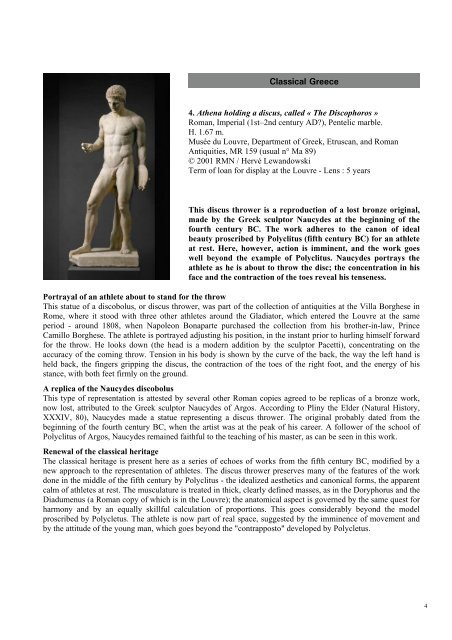The Galerie du Temps at the Louvre-Lens A unique presentation of ...
The Galerie du Temps at the Louvre-Lens A unique presentation of ...
The Galerie du Temps at the Louvre-Lens A unique presentation of ...
Create successful ePaper yourself
Turn your PDF publications into a flip-book with our unique Google optimized e-Paper software.
Classical Greece<br />
4. A<strong>the</strong>na holding a discus, called « <strong>The</strong> Discophoros »<br />
Roman, Imperial (1st–2nd century AD?), Pentelic marble.<br />
H. 1.67 m.<br />
Musée <strong>du</strong> <strong>Louvre</strong>, Department <strong>of</strong> Greek, Etruscan, and Roman<br />
Antiquities, MR 159 (usual n° Ma 89)<br />
© 2001 RMN / Hervé Lewandowski<br />
Term <strong>of</strong> loan for display <strong>at</strong> <strong>the</strong> <strong>Louvre</strong> - <strong>Lens</strong> : 5 years<br />
This discus thrower is a repro<strong>du</strong>ction <strong>of</strong> a lost bronze original,<br />
made by <strong>the</strong> Greek sculptor Naucydes <strong>at</strong> <strong>the</strong> beginning <strong>of</strong> <strong>the</strong><br />
fourth century BC. <strong>The</strong> work adheres to <strong>the</strong> canon <strong>of</strong> ideal<br />
beauty proscribed by Polyclitus (fifth century BC) for an <strong>at</strong>hlete<br />
<strong>at</strong> rest. Here, however, action is imminent, and <strong>the</strong> work goes<br />
well beyond <strong>the</strong> example <strong>of</strong> Polyclitus. Naucydes portrays <strong>the</strong><br />
<strong>at</strong>hlete as he is about to throw <strong>the</strong> disc; <strong>the</strong> concentr<strong>at</strong>ion in his<br />
face and <strong>the</strong> contraction <strong>of</strong> <strong>the</strong> toes reveal his tenseness.<br />
Portrayal <strong>of</strong> an <strong>at</strong>hlete about to stand for <strong>the</strong> throw<br />
This st<strong>at</strong>ue <strong>of</strong> a discobolus, or discus thrower, was part <strong>of</strong> <strong>the</strong> collection <strong>of</strong> antiquities <strong>at</strong> <strong>the</strong> Villa Borghese in<br />
Rome, where it stood with three o<strong>the</strong>r <strong>at</strong>hletes around <strong>the</strong> Gladi<strong>at</strong>or, which entered <strong>the</strong> <strong>Louvre</strong> <strong>at</strong> <strong>the</strong> same<br />
period - around 1808, when Napoleon Bonaparte purchased <strong>the</strong> collection from his bro<strong>the</strong>r-in-law, Prince<br />
Camillo Borghese. <strong>The</strong> <strong>at</strong>hlete is portrayed adjusting his position, in <strong>the</strong> instant prior to hurling himself forward<br />
for <strong>the</strong> throw. He looks down (<strong>the</strong> head is a modern addition by <strong>the</strong> sculptor Pacetti), concentr<strong>at</strong>ing on <strong>the</strong><br />
accuracy <strong>of</strong> <strong>the</strong> coming throw. Tension in his body is shown by <strong>the</strong> curve <strong>of</strong> <strong>the</strong> back, <strong>the</strong> way <strong>the</strong> left hand is<br />
held back, <strong>the</strong> fingers gripping <strong>the</strong> discus, <strong>the</strong> contraction <strong>of</strong> <strong>the</strong> toes <strong>of</strong> <strong>the</strong> right foot, and <strong>the</strong> energy <strong>of</strong> his<br />
stance, with both feet firmly on <strong>the</strong> ground.<br />
A replica <strong>of</strong> <strong>the</strong> Naucydes discobolus<br />
This type <strong>of</strong> represent<strong>at</strong>ion is <strong>at</strong>tested by several o<strong>the</strong>r Roman copies agreed to be replicas <strong>of</strong> a bronze work,<br />
now lost, <strong>at</strong>tributed to <strong>the</strong> Greek sculptor Naucydes <strong>of</strong> Argos. According to Pliny <strong>the</strong> Elder (N<strong>at</strong>ural History,<br />
XXXIV, 80), Naucydes made a st<strong>at</strong>ue representing a discus thrower. <strong>The</strong> original probably d<strong>at</strong>ed from <strong>the</strong><br />
beginning <strong>of</strong> <strong>the</strong> fourth century BC, when <strong>the</strong> artist was <strong>at</strong> <strong>the</strong> peak <strong>of</strong> his career. A follower <strong>of</strong> <strong>the</strong> school <strong>of</strong><br />
Polyclitus <strong>of</strong> Argos, Naucydes remained faithful to <strong>the</strong> teaching <strong>of</strong> his master, as can be seen in this work.<br />
Renewal <strong>of</strong> <strong>the</strong> classical heritage<br />
<strong>The</strong> classical heritage is present here as a series <strong>of</strong> echoes <strong>of</strong> works from <strong>the</strong> fifth century BC, modified by a<br />
new approach to <strong>the</strong> represent<strong>at</strong>ion <strong>of</strong> <strong>at</strong>hletes. <strong>The</strong> discus thrower preserves many <strong>of</strong> <strong>the</strong> fe<strong>at</strong>ures <strong>of</strong> <strong>the</strong> work<br />
done in <strong>the</strong> middle <strong>of</strong> <strong>the</strong> fifth century by Polyclitus - <strong>the</strong> idealized aes<strong>the</strong>tics and canonical forms, <strong>the</strong> apparent<br />
calm <strong>of</strong> <strong>at</strong>hletes <strong>at</strong> rest. <strong>The</strong> muscul<strong>at</strong>ure is tre<strong>at</strong>ed in thick, clearly defined masses, as in <strong>the</strong> Doryphorus and <strong>the</strong><br />
Dia<strong>du</strong>menus (a Roman copy <strong>of</strong> which is in <strong>the</strong> <strong>Louvre</strong>); <strong>the</strong> an<strong>at</strong>omical aspect is governed by <strong>the</strong> same quest for<br />
harmony and by an equally skillful calcul<strong>at</strong>ion <strong>of</strong> proportions. This goes considerably beyond <strong>the</strong> model<br />
proscribed by Polycletus. <strong>The</strong> <strong>at</strong>hlete is now part <strong>of</strong> real space, suggested by <strong>the</strong> imminence <strong>of</strong> movement and<br />
by <strong>the</strong> <strong>at</strong>titude <strong>of</strong> <strong>the</strong> young man, which goes beyond <strong>the</strong> "contrapposto" developed by Polycletus.<br />
4



